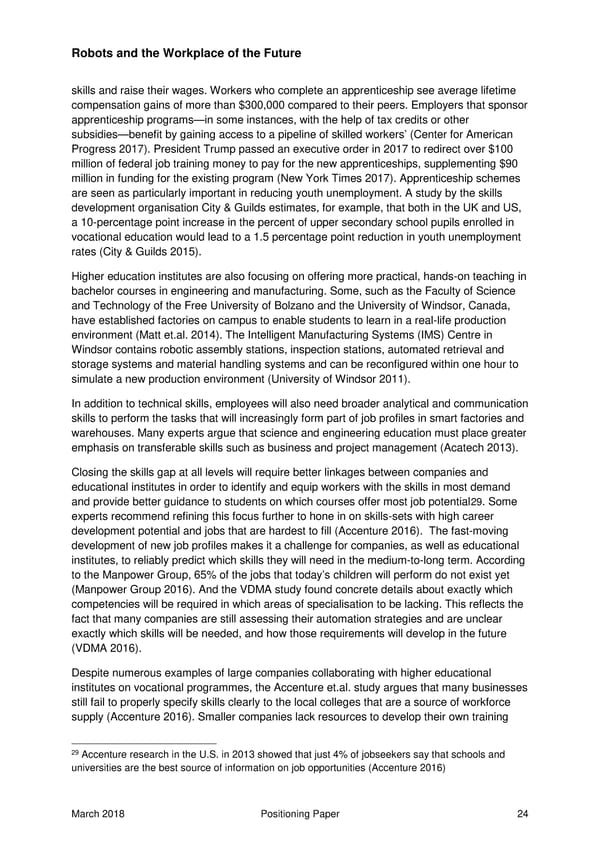Robots and the Workplace of the Future skills and raise their wages. Workers who complete an apprenticeship see average lifetime compensation gains of more than $300,000 compared to their peers. Employers that sponsor apprenticeship programs—in some instances, with the help of tax credits or other subsidies—benefit by gaining access to a pipeline of skilled workers’ (Center for American Progress 2017). President Trump passed an executive order in 2017 to redirect over $100 million of federal job training money to pay for the new apprenticeships, supplementing $90 million in funding for the existing program (New York Times 2017). Apprenticeship schemes are seen as particularly important in reducing youth unemployment. A study by the skills development organisation City & Guilds estimates, for example, that both in the UK and US, a 10-percentage point increase in the percent of upper secondary school pupils enrolled in vocational education would lead to a 1.5 percentage point reduction in youth unemployment rates (City & Guilds 2015). Higher education institutes are also focusing on offering more practical, hands-on teaching in bachelor courses in engineering and manufacturing. Some, such as the Faculty of Science and Technology of the Free University of Bolzano and the University of Windsor, Canada, have established factories on campus to enable students to learn in a real-life production environment (Matt et.al. 2014). The Intelligent Manufacturing Systems (IMS) Centre in Windsor contains robotic assembly stations, inspection stations, automated retrieval and storage systems and material handling systems and can be reconfigured within one hour to simulate a new production environment (University of Windsor 2011). In addition to technical skills, employees will also need broader analytical and communication skills to perform the tasks that will increasingly form part of job profiles in smart factories and warehouses. Many experts argue that science and engineering education must place greater emphasis on transferable skills such as business and project management (Acatech 2013). Closing the skills gap at all levels will require better linkages between companies and educational institutes in order to identify and equip workers with the skills in most demand and provide better guidance to students on which courses offer most job potential29. Some experts recommend refining this focus further to hone in on skills-sets with high career development potential and jobs that are hardest to fill (Accenture 2016). The fast-moving development of new job profiles makes it a challenge for companies, as well as educational institutes, to reliably predict which skills they will need in the medium-to-long term. According to the Manpower Group, 65% of the jobs that today’s children will perform do not exist yet (Manpower Group 2016). And the VDMA study found concrete details about exactly which competencies will be required in which areas of specialisation to be lacking. This reflects the fact that many companies are still assessing their automation strategies and are unclear exactly which skills will be needed, and how those requirements will develop in the future (VDMA 2016). Despite numerous examples of large companies collaborating with higher educational institutes on vocational programmes, the Accenture et.al. study argues that many businesses still fail to properly specify skills clearly to the local colleges that are a source of workforce supply (Accenture 2016). Smaller companies lack resources to develop their own training 29 Accenture research in the U.S. in 2013 showed that just 4% of jobseekers say that schools and universities are the best source of information on job opportunities (Accenture 2016) March 2018 Positioning Paper 24
 Robots & the Workplace of the Future Page 24 Page 26
Robots & the Workplace of the Future Page 24 Page 26